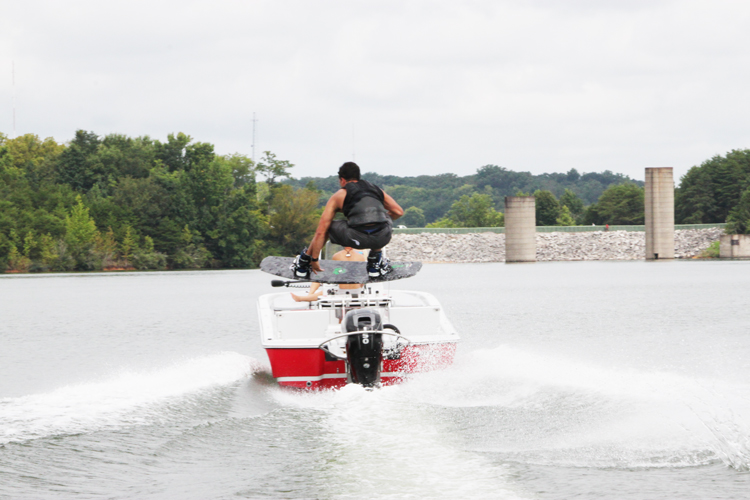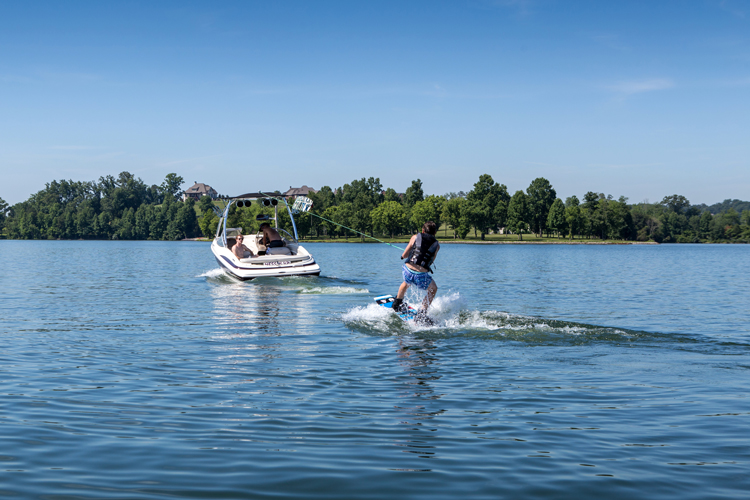The very quick, short answer to “is it safe to wakeboard behind an outboard motor?” is, in many cases, yes. You can wakeboard behind an outboard motor (though we suggest doing so with extra safety precautions, just in case). The tow ropes used for wakeboarding should extend up to 65 feet out from the back of the boat, giving a rider enough space and time to react to sudden changes, and there are many outboard and inboard/outboard motors specifically designed for wakeboarding and other watersports. However, if you’re wondering whether it’s safe to wakesurf behind an outboard motor, the answer is no.
This guide explains why you shouldn’t wakesurf behind an outboard motor, what boat motors are best for wakeboarding, and how to stay safe when wakeboarding.
Why is it safe to wakeboard behind an outboard motor, but not wakesurf?
Towing a wakesurfer with an outboard or inboard/outboard motor puts the rider at risk and poses a significant safety hazard, but wakeboarding doesn’t pose the same risks.
To explain why wakeboarding behind an outboard motor is safe, let’s start with a quick overview of wakeboarding. Wakeboarding is a popular water sport that involves pulling a rider behind a boat using a tow rope and wakeboard. The wakeboarder’s goal is to ride the wake, or the waves a boat creates, and use them to jump or slide. To create firm, clean wakes, boats need to drive at high speeds, somewhere between 15 and 25 mph. The wakeboarder is pulled around 65 feet away from the back of the boat, so the rider has time to slow down and get out of the way if the boat suddenly stops or slows down.

Wakesurfers are pulled closer to the boat, leaving them with much less time to react should the boat stop abruptly. Being pulled at high speeds then puts the wakesurfer at risk of hitting the motor’s propeller, a risk that exists for both outboard and I/O motors.
To summarize, wakeboarding behind an outboard or I/O motor is safe, but wakesurfing is not. Any time you are participating in a watersport, however, you should take proper safety precautions.
What is the best boat motor for wakeboarding or wakesurfing, and why?
The best boat motor for wakeboarding or wakesurfing is usually an inboard motor. Inboard motors are mounted within the hull of the boat, reducing the risk of injury to the rider by ensuring they stay away from the motor’s propeller. As we mentioned before though, when it comes to wakeboarding you have a lot more options with outboard and I/O motors that have been designed for the watersport.

Generally speaking, the best boats for wakeboarding are those that have enough power to reach the required speeds to tow a rider and create good wake. Wakeboard-specific boats will come outfitted with ballast tanks to maximize efficiency on the water, but this isn’t a requirement. Water ballast bags on non-specialized boats can work as well.
Whether you choose a specialized wakeboarding boat, a sterndrive, or a jet boat, the key component is the motor. Riders may prefer inboard motors for performance because they can create cleaner wakes, making it easier for them to ride and perform tricks, especially beginners.
How can you stay safe while wakeboarding?
To stay safe while wakeboarding, you need the right gear, and both the driver and rider need to stay alert, know agreed-upon signals, and respect their limits.
The first step toward being safe while wakeboarding is ensuring that you have the right gear. Essential wakeboarding gear includes a wakeboard, proper bindings, appropriate attire, a tow rope, and a wakeboard tower. After you have the right gear, you need to focus on three key safety items: staying alert, knowing your signals, and respecting your limits.
Both the boat’s driver and the rider being towed need to always stay alert of their surroundings. The driver has the responsibility of watching the direction of the boat, locations of others on the water, and the status of their rider. It is always recommended to have a second person on board to be a spotter to handle watching the rider. The rider is responsible for watching the boat and their surroundings.
The driver, spotter, and rider all need to know previously agreed-upon hand signals to quickly communicate with each other. Important signals include those related to speed and turns, and safety signals such as “retrieval” or “I’m okay”.
The driver and rider also need to respect their limits. Wakeboarding requires specific boat patterns while driving at higher speeds, so an experienced and confident driver is a must. Riders should also know what level they are at in wakeboarding - beginner, intermediate, or advanced - as this determines what skills and tricks they’re capable of pulling off. Attempting a trick beyond your level can be dangerous, so always know your limits to minimize the risk of injury.
The Final Answer: Wakeboarding Behind an Outboard Motor
When it comes down to it, you shouldn’t wakesurf behind an outboard or outboard/inboard motor, but you can wakeboard with the right safety precautions. You should wakesurf behind an inboard motor to keep the rider safe from harm, but with outboard and I/O motors designed for wakeboarding, you have more options with that watersport. Other safety measures include staying alert to your surroundings, knowing hand signals, and knowing your limits. These apply to both the boat driver and the rider being towed. Wakeboarding is an exciting sport that offers a major adrenaline rush and can be extremely rewarding for people of all ages, but as with anything, it’s important to be prepared!













Comments